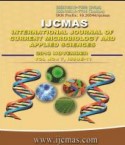


 National Academy of Agricultural Sciences (NAAS)
National Academy of Agricultural Sciences (NAAS)

|
PRINT ISSN : 2319-7692
Online ISSN : 2319-7706 Issues : 12 per year Publisher : Excellent Publishers Email : editorijcmas@gmail.com / submit@ijcmas.com Editor-in-chief: Dr.M.Prakash Index Copernicus ICV 2018: 95.39 NAAS RATING 2020: 5.38 |
Mango is acknowledged as the king of fruit and one of the best fruits in the world market because of its great utility, excellent flavour, attractive fragrance, and beautiful shades of colour, delicious taste and healthful value. The nutritive value of fruit beverage is better than synthetic ones. Looking at the demand there is a great scope in the country for production of fruit juices and other fruit based beverages. Ten varieties of mango were chosen and were processed followed by statistical analysis done. Maximum fruit weight and pulp weight was recorded 380g and 266.76g, respectively, from Kakna (local) which was 70.2 per cent of the total fruit weight. The seed weight and non-edible waste in mango fruit were recorded 74.17g and 155.52g respectively. The calculated value of these two parameters are 19.51 per cent and 40.92 per cent, respectively of total fruit weight, whereas pulp:seed ratio was calculated 4.38 maximum for Dashehari. Data with respect to chemical composition of fruits revealed that maximum value of total soluble solids (TSS) was recorded 220Brix from Mallika. The maximum value of total sugar and non-reducing sugar content was recorded 17.81 per cent, 13.81 per cent respectively from Mallika The maximum value of ascorbic acid content was recorded 56.34 mg/100ml from Langra. Whereas maximum titrable acidity was recorded 0.35 per cent from totapari, pH value was recorded maximum 3.75 in Totapari. A little attention has been made so far in the field of fruit processing technology in Chhattisgarh region. Hence, there is an urgent need to evaluate different varieties of mango for different preserved products of mango.
 |
 |
 |
 |
 |